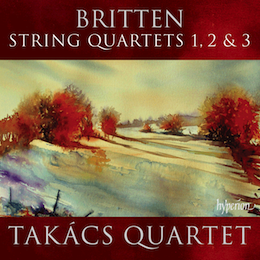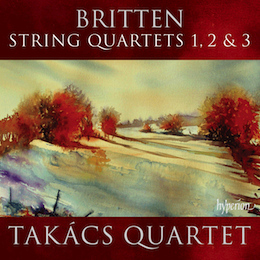
It’s strange how insular (pun, I’m afraid, intended) British chamber music is. No one assumes that the Janáček quartets are the exclusive province of Czech string quartets, or the Bartók quartets of Hungarian ones, or the Shostakovich quartets of quartets from the former U.S.S.R. But, until recently, it was rare indeed to find a quartet from outside Britain playing British string quartets. Elgar? Bridge? Tippett? Delius, heaven help us? Don’t they have people at home to play this stuff?
Now, I happen to hold a brief for the Elgar quartet, and also for Frank Bridge’s Third and Fourth, which I think belong on a level with Ruth Crawford Seeger’s magnificent quartet. But as this is the centenary of Benjamin Britten’s birth, I might as well start there.
The Britten quartets deserve a lot more attention than they have gotten outside Britain. And now they might possibly, finally, be getting it.
The three numbered quartets differ extensively. The First (composed in 1941) begins with what has to be the most arresting texture in the history of the string quartet. The three upper strings are all up in the stratosphere, closely spaced; way below them is the cello, played pizzicato. It’s at once serene and slightly unsettled, because the upper strings aren’t ever quite at harmonic rest.
From there, things take off. What the piece does is burgeon, whenever and wherever it sees the opportunity. The moment the first movement gets going in earnest, the upper strings are all overtopping one another. The second-movement scherzo does the same thing: Everyone is in unison, until one player breaks out into triplets, and then soon it’s someone else doing it, and then, well, everyone is doing it.
Even the slow movement does this. It’s a sort of slow dirge in 5/4 time, but eventually it breaks loose: first the cello, then the viola, then both violins are free.
The finale is usually critiqued as “Haydnesque.” Formally, it owes practically nothing to Haydn, but its essence really is like Haydn. It messes around with motifs and themes simply for the fun of it. (Why would anyone play with notes, except for fun?) The giddy exuberance with which the opening gesture is duplicated, reduplicated, tumbled over and over, turned upside down and right-side up again, and finally made into a cascade of sheer, mad exaltation — well, it’s all brilliant.
You can be aware of the cleverness … at the same time that you’re carried away by the musical narrative. … You’re thinking “what the hell is that?”
The Second Quartet (Op. 36, 1945), at first glance, encapsulates everything that most irritates some people about Britten. This is a piece written by the guy who structured an entire opera (The Turn of the Screw) as a variation-set. The first movement opens with a rising tenth interval, and we get that over and over again, initially to introduce the three melodic phrases that make up the main material of the movement. By the time we get around to the recapitulation, those three clauses have been diced, sliced, hashed, and flipped, and at the recap proper they’re unleashed all at once.
But then comes a scherzo in which everything is immediately turned upside down and inside out, with the alarming trio (more or less a pandemoniacal blues) being run by the scherzo’s main theme, at half speed and in a radically different context.
And then comes the main movement, the Chacony (the quartet was written to commemorate the 250th anniversary of Henry Purcell’s death, and chacony was the way Purcell spelled chaconne). Britten writes a theme in chaconne rhythm, but one so quirky and so odd that he can spend a quarter of an hour taking it to pieces and reassembling it. It’s all seemingly mechanical: Such and such number of variations about harmony; cello cadenza; such and such number of variations about rhythm; viola cadenza; such and such number of variations about melody; violin cadenza; and a couple more to wrap it all up.
Except that it doesn’t seem mechanical at all — not in the playing, nor in the listening. You can be aware of the cleverness — and even be annoyed by it — at the same time that you’re carried away by the musical narrative. When you hit the triplet variation just before the viola cadenza, you’re no longer thinking that Britten was surely one heck of a nerd; instead, you’re thinking “what the hell is that?”
As for the Third Quartet, coming 30 years later (1975), it’s different again from its siblings. Its humor is more savage than the First’s, its design less obvious than the Second’s. Everything in it seems more precarious. Between two mockingly grotesque scherzos comes an impossibly beautiful slow movement built like a high-wire act: There’s nothing below the first violin but the cello far, far underneath, and everything moves slowly and with trepidation. Until there’s a kind of ecstatic explosion, when the first violin bursts into idealized birdsong, and harmonics and glissandos are everywhere.
On the outsides are a movement called “Duets,” which is what it says — two quartet players at a time in tandem, until the dueling duos are all in the mix together — and then a final passacaglia, the theme drawn from Britten’s last opera, Death in Venice, but here drawn out far into the “perilous sweetness” of the libretto.
The Takács Quartet’s performances could hardly be better … possibly the best we have.
The Third is now, I am glad to see, a standard repertoire item. Indeed, it seems to me to occupy roughly the place that the Bartók Fourth Quartet did some 30 years ago; it’s the piece that young ensembles use to demonstrate that they can handle difficult 20th-century music.
I first got to know this music, in the late 1980s, via a marvelous box of LPs by the Endellion Quartet. It was then billed as the complete Britten music for string quartet. It couldn’t be so billed now — for another early piece has turned up (and has been recorded, with great enthusiasm, by the Sorrel Quartet) — but it comes close.
Today, 27 years later, the Endellions have made a second recording of the three “numbered” quartets, plus the Three Divertimenti (sharp snippets from 1936 that really ought to be better known). I find it curiously difficult to decide whether I like the earlier or the new performances better. It is recognizably the same ensemble — Garfield Jackson’s dense, incisive viola tone is unmistakable, for starters — but subtle interpretative differences are heard, mainly in a greater latitude about rubato. This is an ensemble that has played all this music, I’m guessing, every year for several decades. It’s been lived in, and loved, for easily that long. And yet it’s the crisp, almost businesslike approach of the younger Endellions that I find myself loving more. Likely that’s because it’s those recordings that got the music into my head in the first place.
The first Endellion Britten set was recorded for EMI, a label that has its downsides, among which is its propensity to delete recordings rapidly. The upside to that is that EMI also maintains a massive back catalog, and whenever an occasion arise (like, say, the Britten centenary), there’s material to spare. So here are the early Endellion performances, together with the majority of the other Britten chamber music, plus most of his small output of solo piano music.
The Britten quartets are now, like the Haydn and Mozart and Beethoven and Bartók quartets, the sort of music that … you might record more than once.
Some omissions are to be noted, the most grievous being the viola/piano Lachrymae, yet there’s no better single collection of Britten’s chamber music to be had at any price. Truls Mørk’s resonant-toned and supple accounts of the three solo cello suites are in there, as are San Francisco Symphony Concertmaster Alexander Barantschik’s recording (with pianist John Alley) of the spiky Op. 6 Suite for violin and piano, as well as the fine recording by Moray Welsh and John Lenehan of the Op. 65 Cello Sonata. (Which apparently will now have to be considered the Cello Sonata No. 2, since someone has unearthed a cello sonata that Britten wrote at all of 13, and has even recorded it.)
Still, the extra fun in the box is the “juvenilia” for string quartet that the Endellions recorded — quite a lot of music, wildly diverse stylistically. The piece that stands out for me is the Quartettino of 1930, a piece that makes clear that Britten was listening to the likes of Alban Berg and the later music of Frank Bridge (with whom he was then studying). Dip into the other early pieces and you find a precocious personality who adopted a multitude of styles, as they struck him. There’s a strong Francophile streak, not to mention a yen for unlikely sonorities. The 1932 viola-quintet Phantasy is practically a primer in “OK, I have two violas here; what shall I do with them?”
Meanwhile, I should note the new Takács Quartet recording of the three numbered quartets. It’s amazing to me that no one has ever thought to do this before. The three works fit comfortably on a single, long CD, and it’s the most logical coupling in the world. Their performances could hardly be better. The Takács, as an ensemble, must be fairly new to this music, but they obviously relish it enormously. The individual strengths are noted — violist Geraldine Walther’s heady viola tone (so different from Garfield Jackson’s dense, tightly focused one, but also, somehow, sounding exactly right); cellist András Fejér’s deliberate tread through the Third Quartet’s passacaglia, making a crunchy beginning with every note; Edward Dusinberre’s silvery violin sound suspended over the abyss in the same work’s central movement; second violinist Károly Schranz’s gutsy, gritty interventions throughout all three works, a delight that eventually can’t be called “unexpected” any more. And, overall, there is the ensemble strength, by which what ought by rights to sound like a congeries of very fine but utterly different players in fact sounds like a string quartet — possibly the best one we have.
The lessons to take away from these recordings? That the Britten quartets are now, like the Haydn and Mozart and Beethoven and Bartók quartets, the sort of music that an ensemble might linger on, ponder over, revisit repeatedly — the sort of music you might record more than once. And that the Britten quartets aren’t only for Brits any more. They never were, really, but we are finally figuring that out.

